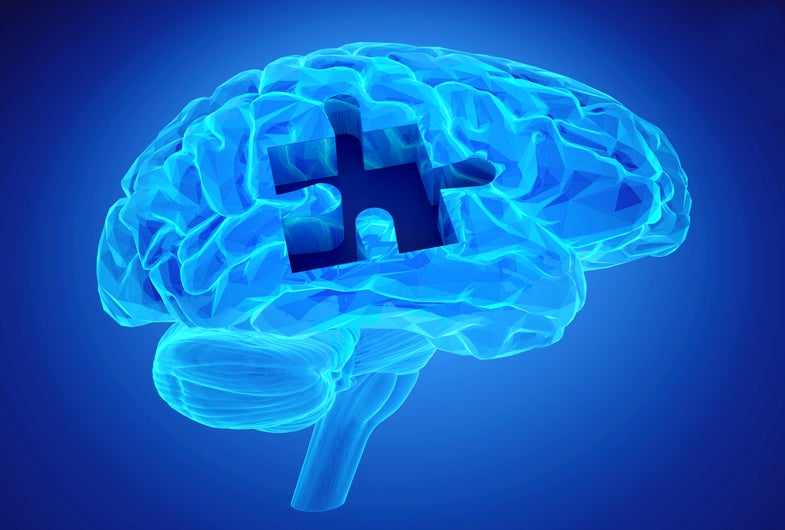A new view of twisted proteins could help scientists understand Alzheimer’s
A critical molecule in the neurodegenerative disease has finally been mapped.

A new study published this month in Nature marks a key milestone in Alzheimer’s research. It demonstrates the first complete model of a tau filament, a protein structure found in the brain cells of Alzheimer’s patients and thought to be the cause of the neurodegenerative disease.
Many scientists believe that tau proteins are the molecular building blocks of Alzheimer’s disease. Within the cell, these proteins clump together and group into tangles. These tangles are thought to inhibit cell communication, form lesions, and eventually cause the memory loss associated with Alzheimer’s. Different arrangements of tau proteins, or “morphologies,” can accompany different neurodegenerative diseases such Parkinson’s.
The new paper, published by a group of researchers from the Medical Research Council’s Laboratory of Molecular Biology at Cambridge, maps the first full structure of those proteins for the first time. The researchers found that the tau filament actually consists of two parts: a solid core that had been previously identified through other methods, and a “fuzzy coat” of more mobile parts that were previously unknown. Seen below in schematic representations from the paper, the protein consists of two paired strands curved into a C-shape.

Until now, efforts to understand tau aggregation (a key process in the formation of symptom-inducing tangles) only looked to the solid core. Now that the full structure has been mapped out, researchers can gain a better understanding of how the molecule actually functions. “The main contribution is really in basic understanding of these filaments at the molecular level, the atomic level,” says Sjors Scheres, a structural biologist and part of the Cambridge team.
The results are the culmination of over 34 years of work by Alzheimer’s researchers. Despite knowing that tau proteins were a crucial element of the disease since the 80s, scientists have been unable to map the full structure—they couldn’t get a clear enough view with existing techniques. The key innovations that allowed the Cambridge team to succeed were in a process called cryo electron microscopy, or cryo-EM (Scheres explains that method in detail here). Improvements to microscopes and software drastically improved the resolution of these atomic-level images.
“I’ve been thinking about this and trying to solve it from first principles for a long time, and I really would never have guessed this very beautiful structure that they came up with,” says Claude Wischik, a longtime Alzheimer’s researcher at Aberdeen University who is currently working to develop a drug therapy but was not involved in the new study.
Intriguingly, the tip of the C-shaped structure is extremely similar to that seen in a species of yeast called Podospora anserina that can form fungal prions—a bent protein that can somehow induce healthy proteins it encounters to mimic its twists and turns. This could mean that the structure holds the secret to the infectious capabilities of both sorts of molecules, potentially explaining the ability of the tau protein to convince other, healthy proteins to morph into the diseased shape associated with neurodegenerative disease.
“What it will help to do going forward is to zero in on the bit of the molecule where our drug as a prototype is working, and to find better drugs,” Wischik adds. He is especially hopeful for the potential of small molecules to work their way into the tau protein filament and break it up into structures the cell can get rid of.
Just this week, researchers from the Washington University School of Medicine published work on Alzheimer’s and disrupted sleep (which we covered when it was first announced). Their work is one example of how crucial the understanding of tau filaments is to figuring out the cause of the disease: they measured levels of tau in the brain after regular and disrupted sleep, investigating the brain’s ability to clean out the damaging molecules overnight. They found that deep sleep seemed to be key to keeping tau tangles at bay. Seeing the tau structure at high resolution could help them understand the molecular mechanisms behind that deep-sleep clean up.
Taking a larger view, it will still be a long time before effective Alzheimer’s drugs reach the hands of those suffering from the disease. But set in motion by the improvements in the cryo-EM process and the dedicated work for many scientists in molecular biology, we now have a pathway to understanding exactly how Alzheimer’s affects the brain. We’re one step closer to understanding why we and our loved ones lose our memories and cognitive abilities, and finding an effect way to treat it.